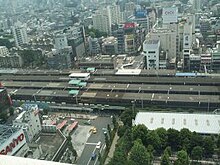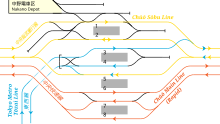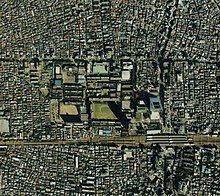Nakano train station
| Nakano ( 中 野 ) | |
|---|---|
|
View from the south (September 2006)
|
|
| Data | |
| Location in the network | Through station |
| Platform tracks | 8th |
| abbreviation | JB07 / JC06 / T-01 |
| opening | April 11, 1889 |
| location | |
| City / municipality | Nakano |
| prefecture | Tokyo |
| Country | Japan |
| Coordinates | 35 ° 42 '22 " N , 139 ° 41' 2" E |
| Height ( SO ) | 30 m TP |
| Railway lines | |
| List of train stations in Japan | |
The Nakano train station ( Japanese 中 野 駅 , Nakano-eki ) is a train station on the Japanese island of Honshū . It is located in the Nakano district of the capital Tokyo and is jointly operated by the JR East railway company and the Tōkyō Metro subway company .
links
Nakano is a through station on the Chūō main line from Tokyo via Shinjuku to Shiojiri , the tracks of which are identical to those of the Chūō high-speed railway line Tokyo – Shinjuku– Takao . The Chūō-Sōbu line runs partly parallel to this from Mitaka via Akihabara to Chiba . All three lines are operated by the JR East railway company. In addition, Nakano is the western terminus of the Tōzai line of the company Tōkyō Metro , which runs through downtown Tokyo to Nishi-Funabashi . In addition, this subway line is tied through at both ends to the Chūō-Sōbu line ; on the one hand from Nakano to Mitaka , on the other hand from Nishi-Funabashi to Tsudanuma .
Three pairs of express trains of the Holiday Rapid Okutama from Shinjuku via Tachikawa to Oku-Tama (or as Holiday Rapid Akigawa to Musashi-Itsukaichi ) stop in Nakano on weekends and public holidays . The regional traffic on the Chūō rapid transit line is very dense and consists of a complex system of express and local trains with train schedules of a few minutes. The starting points are usually Tokyo in the east and Takao and Ōtsuki in the west. Some of these trains run beyond Ōtsuki to Kawaguchiko or switch to the Ōme line in Tachikawa .
Local traffic through the inner Tokyo suburbs is handled on the Chūō-Sōbu line, which has its own tracks and is operationally independent of the other two lines. During rush hour, the train sequence is only two minutes, with several trains running west of Mitaka to Musashi-Koganei and only turning there. During the day, nine trains are offered every hour. Except during the morning rush hour and in the late evening, up to five subways of the Tōzai line run every hour via the nominal terminus Nakano to Mitaka.
There are large bus terminals with several stops on both the northern and southern station forecourt . These are used by around three dozen lines of the companies Kantō Bus , Keiō Dentetsu Bus , Kokusai Kyōgyō Bus , Ryobi Bus , Toyotetsu Bus and Airport Transport Service .
investment
The station stands on a viaduct in the Higashinakano district, which is part of the Nakano district. The underpass of the four-lane main road Nakano-dōri runs from north to south under the viaduct . The facility is oriented from east to west and has nine tracks, eight of which are used for passenger traffic. These are located on four covered central platforms . Stairs and escalators lead up to the platforms. The JR East trains stop on tracks 1 and 2 and 5 to 8, and the Tōkyō Metro trains on tracks 3 to 5. Both companies therefore share the facility and there are no platform barriers to pass when changing trains . The southernmost track is not on a platform, but serves as an entrance to the JR East Depot Nakano. It includes a three-track wagon shed and nine additional outdoor sidings .
There are some important buildings in the vicinity for visitors to the Nakano district. The Sun Mall and Nakano Broadway are on the northern forecourt of the station. These are known as the headquarters of Mandarake , a second-hand dealer for everything related to the otaku culture. The district administration and the Nakano Sun Plaza, which includes a hotel and a large concert hall, are located to the northwest of the train station. The head office of the Marui department store chain is also located near the train station . The public library and the Nakano Zero culture and event center can be reached via the south exit.
In the 2017 fiscal year, an average of 230,047 passengers used the station every day. Of these, 148,789 were accounted for by JR East and 81,258 by Tōkyō Metro.
Tracks
| 1 | ▉ Chūō-Sōbu line | Shinjuku • Akihabara • Nishi-Funabashi • Chiba |
| 2 | ▉ Chūō-Sōbu line | Mitaka |
| 3 |
|
arriving subways, connection to Mitaka |
| 4th |
|
Iidabashi • Ōtemachi • Nishi-Funabashi |
| 5 | ▉ Chūō-Sōbu line | Shinjuku • Akihabara • Chiba |
|
|
tied subways from Mitaka to Tsudanuma | |
| 6th | ▉ Chūō rapid transit line | Mitaka • Tachikawa • Hachiōji • Takao |
| 7 • 8 | ▉ Chūō rapid transit line | Shinjuku • Tokyo |
history
The private railway company Kōbu Tetsudō opened the station on April 11, 1889, along with the Shinjuku - Tachikawa section of the Chūō main line . Its original location was about a hundred meters west of today's reception building . On October 1, 1906, the Kōbu Tetsudō was nationalized . In connection with the expansion of the line, the Ministry of Railways moved the station to its current location in 1929. At the same time a street underpass was built to lead the Nakano-dōri from the north to the south side. On May 16, 1963, the Japanese State Railways gave up cargo handling. While the Shinjuku – Nakano section had already been expanded to four tracks since October 15, 1928, a second pair of tracks was put into operation on March 16, 1966 between Nakano and Ogikubo .
On March 25, 1964, the Teito Kōsokudo Kōtsū Eidan ( Eidan for short, known as the Tōkyō Metro since privatization in 2004 ) opened a 3.9 km long section of the Tōzai line from Waseda to Nakano, which now provides a connection to the underground Railway network existed. As part of the privatization of the state railway, the station went into the possession of the new company JR East on April 1, 1987 (together with Eidan). One day earlier, JR Freight resumed cargo handling on a limited scale.
Adjacent train stations
|
←
|
Lines |
→
|
||
|---|---|---|---|---|
| Shinjuku |
|
Koenji | ||
| Higashi-nakano |
|
Koenji | ||
| Beginning |
Tōkyō Metro |
Ochiai | ||
Web links
- JR East Station Information (Japanese)
Individual evidence
- ↑ a b JR 時刻表 2019 年 3 月 号 (JR timetable March 2019). Kōtsū shinbunsha, Tokyo 2019.
- ↑ 各 駅 の 乗車 人員 (2017 年度). JR East , 2018, accessed December 17, 2019 (Japanese).
- ↑ 東京 都 統計 年鑑 平 成 29 年. (Tokyo Prefecture Statistical Yearbook 2017). Tokyo Metropolitan Government , 2018, accessed December 17, 2019 (Japanese).
- ↑ a b Tetsu Ishino (Ed.): 停車場 変 遷 大事 典 国 鉄 ・ JR 編 (station change directory JNR / JR) . JTB, Tokyo 1998, ISBN 978-4-533-02980-6 .
- ^ Tokyo. urbanrail.net, 2019, accessed on December 17, 2019 .





